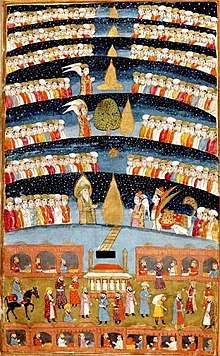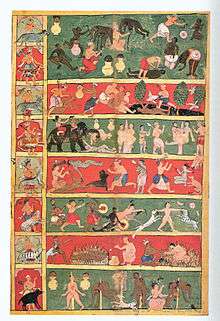Seven Heavens
In religious or mythological cosmology, the seven heavens refer to seven layers of the sky. These were associated in ancient times both with the metaphysical realms of deities and with observed celestial bodies such as the classical planets and fixed stars.[1] The concept, derived from ancient Mesopotamian religions, can be found in the Abrahamic religions such as Islam, Judaism and Christianity; a similar concept is also found in some Indian religions such as Hinduism.[2] Some of these traditions, including Jainism, also have a concept of seven earths or seven underworlds.
The number seven corresponds to the seven classical planets known to antiquity. Ancient observers noticed that these objects moved at different paces in the sky both from each other and from the fixed stars beyond them: Mercury, Venus, the Moon, the Sun, Mars, Jupiter, and Saturn. Unlike comets, which appeared in the sky with no warning, they did move in regular patterns that could be predicted.[3] They also observed that objects in the sky influenced objects on earth, as when movements of the sun affect the behavior of plants or movements of the moon affect ocean tides.
Observations like these led to the development across generations of geocentric cosmologies: earth-centered ideas about the structure of the universe. In some cultures the layers, or "heavens", in the sky were understood as vast spheres. Each rotated around the earth at its own pace, taking its associated point of light, and any associated heavenly beings, along. Speculation spread about the effect all celestial objects--not only the sun and moon, but other points of light such as Mars, Jupiter, and fixed stars--might exercise over earthly events. Stories and symbolic associations followed.
Mesopotamian religion
The concept of seven heavens as developed in ancient Mesopotamia symbolised both physical and metaphysical concepts.[4] In the Sumerian language, the words for heaven (or sky) and earth are An and Ki.[5] Sumerian incantations of the late second millennium BCE make references to seven heavens and seven earths. One such incantation is: "an-imin-bi ki-imin-bi" (the heavens are seven, the earths are seven.)[1][6]
The understanding that the heavens can influence things on earth lent heavenly, magical properties to the number seven itself, as in stories of seven demons, seven churches, seven spirits, or seven thrones. The number seven appears frequently in Babylonian magical rituals.[7] The seven Jewish and the seven Islamic heavens may have had their origin in Babylonian astronomy.[1]
In general, heaven is not a place for humans in Mesopotamian religion. As Gilgamesh says to his friend Enkidu, in the Epic of Gilgamesh: "Who can go up to heaven, my friend? Only the gods dwell with Shamash forever". Along with the idea of seven heavens, the idea of three heavens was also common in ancient Mesopotamia.[8]
Islam

The Qur'an frequently mentions the existence of seven samaawat (سماوات), plural of samaa'a (سماء), which is customarily translated as 'heaven'. The word is cognate to Hebrew shamayim (שמים). Some of the verses in which Qur'an mentions seven samaawat,[9] are [Quran 41:12 (Yusuf Ali)], [Quran 65:12 (Yusuf Ali)], [Quran 71:15 (Yusuf Ali)].
There are two interpretations of using the number "seven". One viewpoint is that the number "seven" here simply means "many" and is not to be taken literally (the number 7 is often used to imply that in the Arabic language).[10] But many other commentators use the number 7 literally.
One interpretation of "heavens" is that all the stars and galaxies (including the Milky Way) are all part of the "first heaven", and "beyond that six still bigger worlds are there," which have yet to be discovered by scientists.[10]
In other sources, the concept is presented in metaphorical terms. Each of the seven heavens is depicted as being composed of a different material, and Islamic prophets are resident in each. The first heaven is depicted as being made of silver and is the home of Adam and Eve, as well as the angels of each star. The second heaven is depicted as being made of gold and is the home of John the Baptist and Jesus. The third heaven is depicted as being made of pearls or other dazzling stones; Joseph and Azrael are resident there.[11] The fourth heaven is depicted as being made of white gold; Enoch and the Angel of Tears resides there. The fifth heaven is depicted as being made of silver; Aaron and the Avenging Angel hold court over this heaven. The sixth heaven is composed of garnets and rubies; Moses can be found here.[12] The seventh heaven, which borrows some concepts from its Jewish counterpart, is depicted as being composed of divine light incomprehensible to the mortal man. Abraham is a resident of the seventh heaven.[13] According to some hadiths, the highest level of Jannah is firdaws,[14] and Sidrat al-Muntaha, a Lote tree, marks the end of the seventh heaven.
According to Shi'ite sources, A Hadith from Imam Ali mentioned the name of Seven Heavens as below:[15]
- Rafi' (رفیع) the least heaven (سماء الدنیا)
- Qaydum (قیدوم)
- Marum (ماروم)
- Arfalun (أرفلون)
- Hay'oun (هيعون)
- Arous (عروس)
- Ajma' (عجماء)
Judaism
According to the Talmud, the universe is made of seven heavens (Shamayim)[16]
- Vilon (וילון), Also see (Isa 40:22)
- Raki'a (רקיע), Also see (Gen 1:17)
- Shehaqim (שחקים), See (Ps 78:23, Midr. Teh. to Ps. xix. 7)
- Zebul (זבול), See (Isa 63:15, KJV)
- Ma'on (מעון), See (Deut 26:15, Ps 42:9)
- Machon (מכון), See (1 Kings 8:39, Deut 28:12)
- Araboth (ערבות), The seventh Heaven where ofanim, the seraphim, and the hayyoth and the throne of the Lord are located.
The Jewish Merkavah and Heichalot literature was devoted to discussing the details of these heavens, sometimes in connection with traditions relating to Enoch, such as the Third Book of Enoch.[17]
Christianity
An explicit reference to the Third Heaven appears in the Christian New Testament canon. A Pauline epistle, penned in Macedonia around 55CE, describes this mystical experience:
I know a person in Christ who fourteen years ago was caught up to the third heaven—whether in the body or out of the body I do not know; God knows. And I know that such a person—whether in the body or out of the body I do not know; God knows—was caught up into Paradise and heard things that are not to be told, that no mortal is permitted to repeat. (2 Corinthians 12.2–4 NRSV)
The description is usually taken as an oblique reference by the author to himself. The passage appears to reflect first-century beliefs among Jews and Christians that the realm of Paradise existed in a different heaven than the highest one--an impression that may find support in the original Greek wording (closer to "caught away" than "caught up").[18]
In the second century, Irenaeus also knows seven heavens (see his Demonstration of Apostolic Preaching 9; cf. Against Heresies 1.5.2).
Over the course of the middle ages Christian thinkers expanded the ancient Mesopotamian seven-heaven model into a system of ten heavens. This cosmology, taught in the first European universities by the Scholastics, reached its supreme literary expression in The Divine Comedy by Dante Aligheri.
Apocryphal Text
The Second Book of Enoch, also written in the first century CE, describes the mystical ascent of the patriarch Enoch through a hierarchy of Ten Heavens. Enoch passes through the Garden of Eden in the Third Heaven on his way to meet the Lord face-to-face in the Tenth (chapter 22). Along the way he encounters vividly described populations of angels who torment wrongdoers; he sees homes, olive oil, and flowers.[19]
The book's depiction of ten heavens represented an expansion of the ancient seven-heaven model. This expanded cosmology was developed further in medieval Christianity.
Hinduism
According to some Puranas, the Brahmanda is divided into fourteen worlds. Among these worlds, seven are upper worlds which constitute of Bhuloka (the Earth), Bhuvarloka, Svarloka, Maharloka, Janarloka, Tapoloka and Satyaloka, and seven are lower worlds which constitute of Atala, Vitala, Sutala, Talatala, Mahatala, Rasatala and Patala.[20]
Seven-level underworlds

- According to Jain cosmology, there are seven levels of Naraka or hell. These are further divided into 8,400,000 other hellish locations.[21]
- Inanna visited the Sumerian seven-gated underworld.
See also
Notes
- 1 2 3 Hetherington, Norriss S. (2014) [1st. pub. 1993]. Encyclopedia of Cosmology (Routledge Revivals) : Historical, Philosophical, and Scientific Foundations of Modern Cosmology. Routledge. pp. 267, 401. ISBN 1-306-58055-2. Retrieved 3 June 2015.
- ↑ Origen, De principiis III,2,1
- ↑ Campbell, Robert. "Aristotle's 'On the Heavens'". Ancient History Encyclopaedia.
- ↑ Barnard, Jody A. (2012). The Mysticism of Hebrews: Exploring the Role of Jewish Apocalyptic Mysticism in the Epistle to the Hebrews. Mohr Siebeck. p. 62. ISBN 3-16-151881-0. Retrieved 3 June 2015.
- ↑ "Sumerian Words And Their English Translation". History World. Retrieved 2 June 2015.
- ↑ Horowitz, Wayne (1998). Mesopotamian Cosmic Geography. Eisenbrauns. p. 208. ISBN 0-931464-99-4. Retrieved 3 June 2015.
- ↑ Collins, Adela Yarbro (2000). Cosmology and Eschatology in Jewish and Christian Apoocalypticism. Brill. ISBN 90-04-11927-2.
- ↑ Lange, Armin; Tov, Emanuel; Weigold, Matthias (2011). The Dead Sea Scrolls in Context: Integrating the Dead Sea Scrolls in the Study of Ancient Texts, Languages, and Cultures. Leiden: Brill. p. 808. ISBN 90-04-18903-3. Retrieved 3 June 2015.
- ↑ Pickthall, M.M.; Eliasi, M.A.H. (1999). The Holy Qur'an (Transliteration in Roman Script). Laurier Books Ltd. ISBN 81-87385-07-3.
- 1 2 "What Is Meant By ‘Seven Heavens’?," Al-Islam.org
- ↑ Richard Webster. "Living in Your Soul's Light: Understanding Your Eternal Self". Missing or empty
|url=(help) - ↑ Peter D'Epiro & Mary Desmond Pinkowish (1998). What Are the Seven Wonders of the World? And 100 Other Great Cultural Lists: Fully Explained. Doubleday. pp. 219–220. ISBN 0-385-49062-3.
- ↑ Hotel and Restaurant Employee's International Alliance & Bartenders' International League of America (1918). Mixer and Server. 27. p. 51.
- ↑ Rustomji, Nerina (2013). The Garden and the Fire: Heaven and Hell in Islamic Culture. Columbia University Press. ISBN 0-231-51183-3.
- ↑ Al-Burhan fi Tafsir Al-Qur'an V.5 P.415
- ↑ "Angelology". Jewish Encyclopedia. Retrieved 16 June 2015.
- ↑ Scholem, Gershom (1965). Jewish Gnosticism, Merkabah Mysticism, and the Talmudic Tradition. New York: Jewish Theological Seminary of America. OCLC 635020.
- ↑ E. W. Bullinger A Critical Lexicon and Concordance to the English and Greek "2, 14, To this "Third heaven" and "Paradise" Paul was caught away, 2 Cor. xii. 2, 4, (not "up", see under "catch") in "visions and revelations of the Lord", 2 Cor. xii. 1. One catching away—with a double revelation of the New heaven and the..."
- ↑ Edward Langton (11 July 2014). Good and Evil Spirits: A Study of the Jewish and Christian Doctrine, Its Origin and Development. Wipf and Stock Publishers. pp. 248–. ISBN 978-1-62564-991-1.
- ↑ Dalal, Roshan (2010). Hinduism:An Alphabetical Guide. Penguin Books. p. 224. ISBN 0-14-341421-6.
- ↑ Jansma, Rudi; Jain, Sneh Rani (2006). Introduction to Jainism. Prakrit Bharti Academy. ISBN 81-89698-09-5.
References
External links
| Wikiversity has learning resources about Seven Heavens |